Installation Instructions
Pool Cover Installation Instructions
NOTE: OBSTRUCTIONS, CUTOUTS OR CABLE AREAS MUST BE INSTALLED FIRST
READ ALL INSTRUCTIONS BEFORE BEGINNING INSTALLATION
Tools Needed:
- Pool Cover, custom fit for installation
- 5 Gallon Buckets ( 6 – 8 )
- Rotary Hammer Drill w/ a 3/4” Concrete Bit
- Installation Rod
- Hammer
- Owner’s Manual & Warranty Information
- Shop Vac
|
- Springs with covers (quantity varies)
- Epoxy
- Brass Anchors (quantity varies)
- Pencil
- Brass Beauty Rings (optional)
- Chalk Line
- Allen Wrench
- Goggles (NOTE: Always wear appropriate eye protection)
|
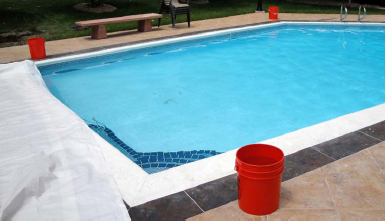 |
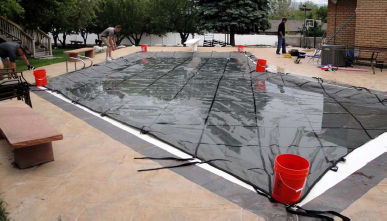
|
| 1. Fill 5 Gallon Buckets with water and place one at each corner of the pool. Place the remaining buckets evenly around the edges of the pool. |
2. Unroll the Cover and place it in position over the pool. Set the Buckets over the Cover’s edges to hold it in place. Adjust cover for equal overlap on all sides. Mark anchor points 18” from cover. |
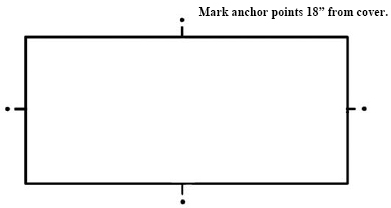
|
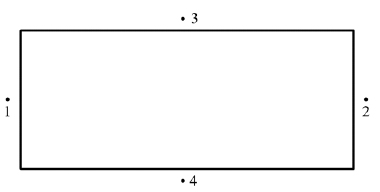
|
| 3. Mark initial 4 anchor points. These should be located at the center strap of each side of the pool. Anchor points must sit 18” from the edge of the cover (not the edge of the pool). They must be in line exactly with each strap. |
4. Initial anchor installation can begin after you determined- the order in which they will be installed. Rayner recommends beginning with the ends of the pool and then moving on to the sides of the pool, as illustrated above. NOTE: Before beginning anchor installation, examine Appendix A: Anchor Installation Specifications to determine ideal tools and methods for different types of decks. |
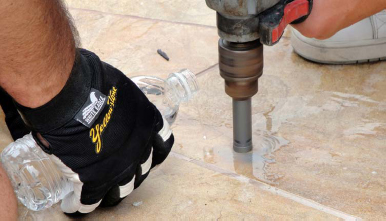 |
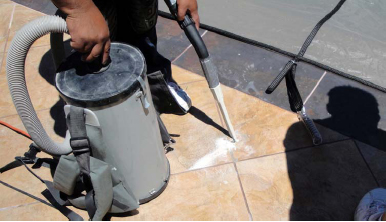 |
| 5. Use the hammer drill with a 3/4” masonry bit to create a neat 3” deep hole in the deck. If necessary use cool water to keep the drill area cool. |
6. Use a shop vac to clear the drill area of debris and water. |
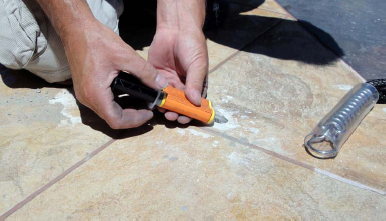 |
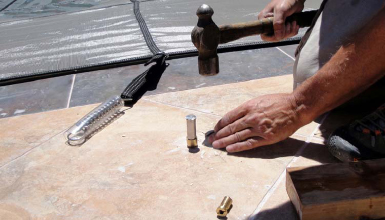 |
| 7. If desired, apply a small amount of epoxy glue to the anchor hole. This will create a stronger hold when the anchor is installed. |
8. Separate the brass insert from the brass anchor casing and set it aside. Use a hammer and tamping tool to push the brass casing into the hole created in Step 5.
-Use extreme caution not to damage the deck.- |
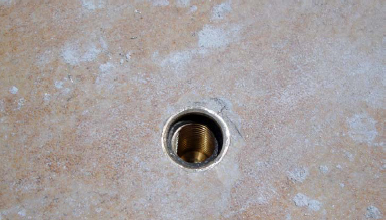 |
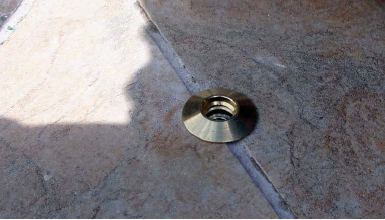 |
| 9. The brass anchor casing must be pressed until the top is flush with the deck surface. (If some slight chipping of the deck has occurred, Anchor Collars may be used to cover the area around the anchor. See Step 10) |
10. If deck chipping makes Anchor Collars necessary, place a ring over the anchor. |
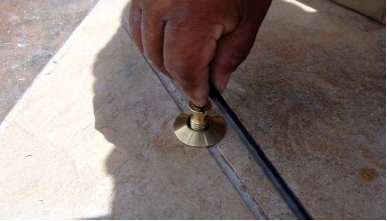 |
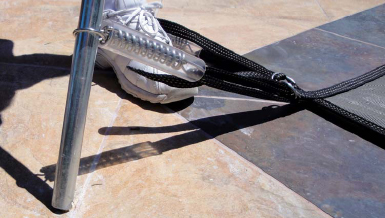 |
| 11. Use the Allen Wrench to insert the anchor insert into the brass casing. Leave approximately 1/3 of the anchor insert above the deck surface. (This instruction is the same if anchor collars are not used.) |
12. Fasten springs to each of the 4 straps. Tighten straps until springs are compressed by 50%. Place the end of the installation Rod through the loop at the end of the Spring. Slide the loop up the Rod until the rod end can be placed over the anchor. |
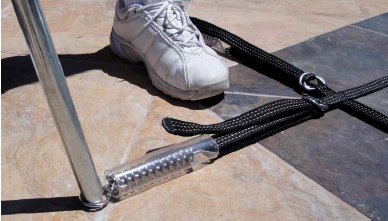 |
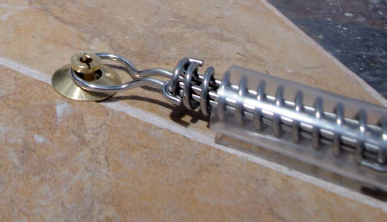 |
| 13. Slide the Spring down the rod to the deck. Twist the rod to release it from the loop and pull it away from the anchor. |
14. The Strap Spring loop should now be held in place by the anchor top. The strap should be held taut. Repeat these steps to install an anchor at each of the 4 straps and then pull the straps onto the anchors. |
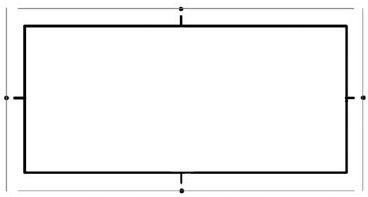 |
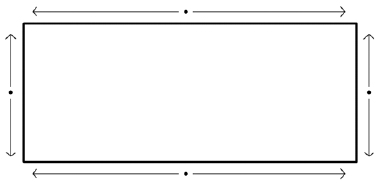 |
| 15. Snap a chalk line 18” from the edge of the cover on all four sides of the pool. (This line should be aligned with the 4 initial anchors installed already.) This chalk line will ensure that the remaining anchors will be aligned. |
16. When center straps have been secured to the anchors, begin installing the rest of the anchors. When all anchors have been installed, secure the remaining straps by working your way from the center anchors to the corners, as shown in the illustration above. |
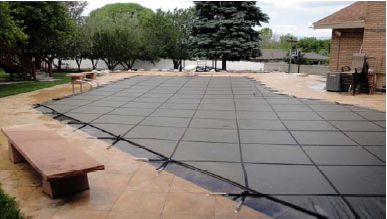 |
|
| 17. Inspect your installation. When complete, the Cover will be held taut, roughly even with the deck surface. It should not be drooping down on the pool water. Make sure all springs are no more than 50% compressed. |
|
|
|
Appendix A: Anchor Installation Specifications:
For Concrete Decks:
– Use a Rotary Hammer Drill w/ 3/4” Masonry Bit; create 3” deep anchor holes.
For Wood Decks:
– Use a Drill w/ 1 ½” Self-Boring Bit; countersink a hole 1/8” deep. Drill a 3/4” diameter hole at least 2” deep directly in the center of the hole. Use provided wood screws to secure the anchor to the deck.
For Brick or Stone Decks:
– Use a Rotary Hammer Drill w/ 1” Masonry Bit; drill through brick or stone to soft ground. Be extremely careful not to cause damage to brick or stone when drilling.
Appendix B: Raised Areas:
Walls, waterfalls, or elevated spas must have special treatment since there is no deck available to secure an anchor cable buddies will be needed. See instructions for installing a cable kit.
IMPORTANT: When installing a cover with a raised area, this section of the cover MUST be installed first.
1. Locate the section of the cover showing no straps. You will find D-rings under the edge of the cover.
2. Stretch the cover over the pool making sure it is positioned correctly in area to be cabled. Use buckets of water to hold the cover. Adjust for exact overlap, keeping in mind that there will be no overlap in raised wall area. The cover will butt up to the wall.
3. Determine where the cable buddies will be drilled into the obstruction based on the d-ring locations. Install cable buddies per the manufacturer’s instructions.
4.Run cable thru d-rings and hook d-rings to cable buddies.
5.Using the cable clamp make a loop on one end of the cable and use clamp to hold in place. Hook this to a deck anchor at the beginning of the cabled area.
6. Using the turn buckle for the other end of the cable run cable thru turn buckle and hold in place with a cable clamp. Hook the turn buckle to a deck anchor at the other end of the cabled area. Once all d-rings are in place tighten the turn buckle to tighten cable.
7. Once this is completed you can continue with the rest of the cover installation. |
Appendix C: Spring Installation:
1. Pull end of strap through the first opening in the buckle.
2. Continue down through the middle opening.
3. Place flat end of spring on strap.
4. Pull strap back up through the middle.
5. Pull strap down through the remaining opening.
6. The protective spring cover is an important safety feature
and should always be placed over the length of the spring.
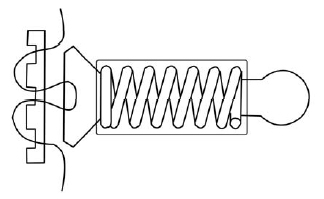
|


















